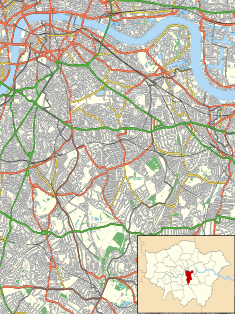Dixon Hotel, Tooley Street
| Dixon Hotel | |
|---|---|
 "Quite spectacular of its date"[1] | |
| Type | Hotel |
| Location | Southwark, London |
| Coordinates | 51°30′08″N 0°04′36″W / 51.5023°N 0.0767°WCoordinates: 51°30′08″N 0°04′36″W / 51.5023°N 0.0767°W |
| Built | 1904-1906 |
| Architect | John Dixon Butler |
| Architectural style(s) | Baroque Revival |
| Owner | Marriott International |
Listed Building – Grade II | |
| Official name | Tower Bridge Magistrates Court and Police Station and attached railings |
| Designated | 17 September 1998 |
| Reference no. | 1385973 |
 Location of Dixon Hotel in London Borough of Southwark | |
The Dixon Hotel, in Tooley Street in the London borough of Southwark is a former magistrates' court and police station designed by John Dixon Butler. Opened in 1906, it operated as a court until closure in 2013. Subsequently sold, it re-opened as The Dixon, a hotel operating as part of the Marriott International group, in 2019. It is a Grade II listed building.
History and description[]
John Dixon Butler (1856-1920) was an architect who in 1895 succeeded his father as Architect and Surveyor to the Metropolitan Police.[2][3] Apprenticed to R. Norman Shaw, he worked under Shaw on the designs for New Scotland Yard;[a][4] the position being reversed at Canon Row Police Station where Butler was the lead architect and Shaw the assisting consultant,[5][6] and went on to design over 200 public buildings, predominantly courts and police stations, across London.[7] Historic England describes him as "one of the most accomplished Metropolitan Police architects".[3] His architectural style was predominantly Baroque Revival and he was much influenced by his early work with Shaw.[b][5]
The Dixon Hotel was designed as the Tower Bridge Police Court, latterly Tower Bridge Magistrates' Court and Police Station,[9] in 1904 and opened in 1906.[10] Built in stone and red brick laid in Flemish bond, the style is "Edwardian Baroque".[10] The London: South Pevsner describes it as "quite spectacular of its date".[1] It features doorcases with elaborate hoods, which became something of a Dixon Butler trademark.[1] From the 1970s the Police Station at Tower Bridge was one of four bases for the Metropolitan Police’s Flying Squad, which specialised in responses to high-value armed robbery.[11] The court closed in 2013 and was subsequently sold,[12] re-opening as a hotel in 2019.[13][14] The hotel's Courtroom Bar is located in the original magistrates' courtroom and a chandelier in the lobby is constructed from old handcuffs.[15]
Notes[]
- ^ The Historic England entry for New Scotland Yard incorrectly records J. Dixon Butler as R. Dixon Butler.[4]
- ^ The architectural style employed by Shaw and Dixon Butler at New Scotland Yard was controversial. Shaw had been selected for the commission by the Home Secretary, Henry Matthews. His predecessor as Home Secretary, Sir William Harcourt repeatedly attacked the new building's design, "it is rather inferior in architectural beauty to the premises of Messrs. Crosse & Blackwell which face it on the other side of the river", going on to quote Byron, "the most recent was the least decent".[8]
References[]
- ^ a b c Cherry & Pevsner 2002, p. 602.
- ^ "John Dixon Butler". Oxford Reference. Retrieved 27 November 2020.
- ^ a b Historic England. "Hampstead Police Station and Magistrates' Court (Grade II) (1130397)". National Heritage List for England. Retrieved 27 November 2020.
- ^ a b Historic England. "Former New Scotland Yard, Norman Shaw North Building (Grade I) (1274511)". National Heritage List for England. Retrieved 27 November 2020.
- ^ a b Historic England. "Cannon Row Police Station (Grade II*) (1357244)". National Heritage List for England. Retrieved 27 November 2020.
- ^ "Canon Row". Parliament UK. Retrieved 27 November 2020.
- ^ "Shad Thames Trail" (PDF). Shad Thames Area Management Partnership. Retrieved 29 November 2020.
- ^ Saint 2010, pp. 291–295.
- ^ "Tower Bridge Magistrates' Court (formerly Tower Bridge Police Court)". National Archive of the UK. Retrieved 29 November 2020.
- ^ a b Historic England. "Tower Bridge Magistrates Court and Police Station (Grade II) (1385973)". National Heritage List for England. Retrieved 27 November 2020.
- ^ Matthews 1996, p. 11.
- ^ "Writing on the wall: call for moratorium on court closures". Law Gazette. Retrieved 29 November 2020.
- ^ "The Dixon, Tower Bridge". Marriott International. Retrieved 27 November 2020.
- ^ Ivill, Laura (5 April 2019). "Interiors: From lock ups to lock ins, we find out how London's prisons, courtrooms and police station are turning into bars and hotels". CityAM. Retrieved 27 November 2020.
- ^ O’Flaherty, Mark C. (27 March 2019). "Hotel Hit Squad: A hotel in a former magistrate's court? The Dixon is judged to be a guilty pleasure, but the witticisms are criminal". The Telegraph. Retrieved 27 November 2020.
Sources[]
- Cherry, Bridget; Pevsner, Nikolaus (2002). London 2: South. The Buildings of England. Yale University Press. ISBN 978-0-300-09651-4. OCLC 844260066.
- Matthews, Roger (1996). Armed Robbery: Two Police Responses (PDF). Crime Prevention and Detection. Vol. 78. London: Home Office.
- Saint, Andrew (2010). Richard Norman Shaw. New Haven, US and London: Yale University Press. ISBN 9-780300-15526-6.
External links[]
| Wikimedia Commons has media related to The Dixon. |
- Grade II listed buildings in the London Borough of Southwark
- Hotels in London
- Hotel buildings completed in 1906
- Edwardian architecture in London
